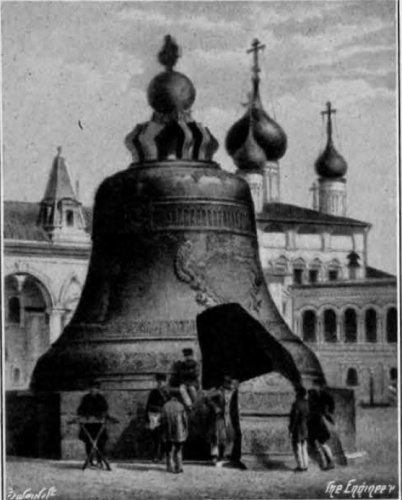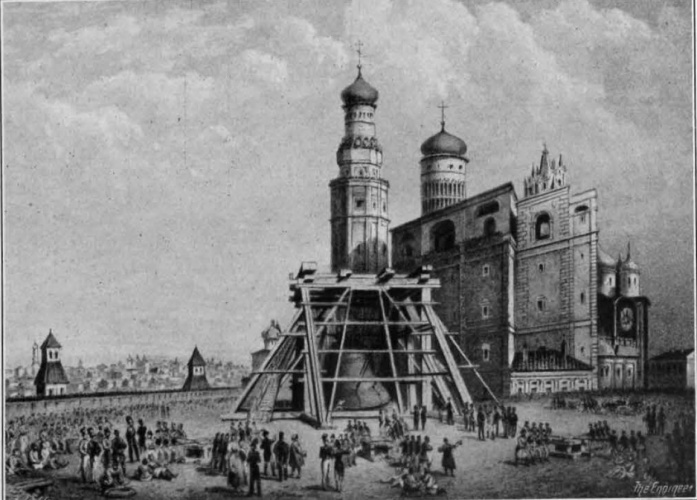The ill-fated Great Bell of Moscow (or Tsar Bell) is now a tourist attraction in The Kremlin, but for 103 years it sat gathering dust in a 33ft-deep pit into which it was cast in 1733 by order of the Empress Anna Ivanovna.

Ivanovna envisioned the Great Bell of Moscow as the successor to Tsar Alexis Mikhailovich’s 100-ton bell, which was destroyed by fire at the Kremlin in 1701.
READ THE ENGINEER'S ORIGINAL COVERAGE OF THE GREAT BELL OF MOSCOW
The new bell was to be taller at 20ft 7in, have a larger diameter (22ft 8in) and weigh in at 200 tons. By 1737 it was being decorated with reliefs and had been hoisted above the casting pit to cool down when another fire broke out in the Kremlin, causing blazing rafters to fall on the bell. In their haste to rescue it, onlookers poured water onto the inferno, which caused the bell to crack and dislodge a piece that weighed 11 tons. The bell fell to the bottom of the pit and, in September 1939, The Engineer’s JR Nichols took a fresh look at the story.
“Some time ago – 27 August 1937 – in a reference to the Great Bell of Moscow in the correspondence columns of The Engineer, the present author mentioned that the raising of so great a weight over a century ago no doubt presented some problems,” he said. “As a result of this remark, an interesting translation of an account of this feat has been received…The author of this account is Monsieur Auguste de Montferrand, who was responsible for raising the bell from the pit in which it had been cast… and placing it on the pedestal on which it still stands.”

Work began on excavations when Montferrand reached Moscow on 25 March 1836, followed by a “strong coffer of carpentry” built around the giant bell and a further six weeks erecting scaffolding and other preparations. Once everything was ready, a date of 1 May was set for the first attempt to raise the bell.
At 10am, the Te Deum having been sung, and in the presence of an immense crowd, the signal was given for soldiers to operate the 12 capstans that had been arranged around the bell.
“I shrunk at first when I considered that any mishap would bring many harms and much revilements from the inhabitants of the city... For blames and praises, honours and dishonours commonly accompany great works, and especially such as be public,” Montferrand recorded. “I would add that, ordinarily, people are more prompt to speak ill when things go evil, than to speak well and esteem the labour should it be in all perfection.”
“The bell began to rise slowly, but not without the breaking of two cables and a sheave of one of the pulleys,” wrote Nichols. “This caused the bell to assume an oblique position, and two further cables broke. The signal was given to stop, and operations were temporarily suspended. The cables, which had been in store some six months, were found to be defective, and new cables were ordered; the capstans were also increased to 20.”
A second attempt was made at 5am on 23 July and by 6.05am the bell, “covered with its ancient dust” was seen to rise slowly from the pit. In under 45 minutes the bell was above ground and the pit was immediately covered with strong rafters and flooring, which received the carriage on to which the bell was lowered, and from where it was hauled up an inclined plane to its pedestal on 26 July.
Nichols noted that the bell was then surmounted by a ball and Greek cross and was stood on an octagonal granite pedestal bearing a marble slab inscribed with a dedication composed by Monsieur Montferrand.
Unable to take the bell as a trophy, Napoleon ordered it to be blown up during the retreat from Moscow in 1812, but only managed to inflict damage on surrounding buildings.
A more benign action was enacted upon the bell in 2016 when a team from UC Berkeley, Stanford University, and the University of Michigan made the Tsar Bell ring for the very first time. To do so, they calculated the thickness, shape, movement and materials used to make the bell and created a computational model that simulated the real thing.










Deep Heat: The new technologies taking geothermal energy to the next level
No. Not in the UK. The one location in the UK, with the prospect of delivering heat at around 150°C and a thermal-to-electrical efficiency of 10-12%,...